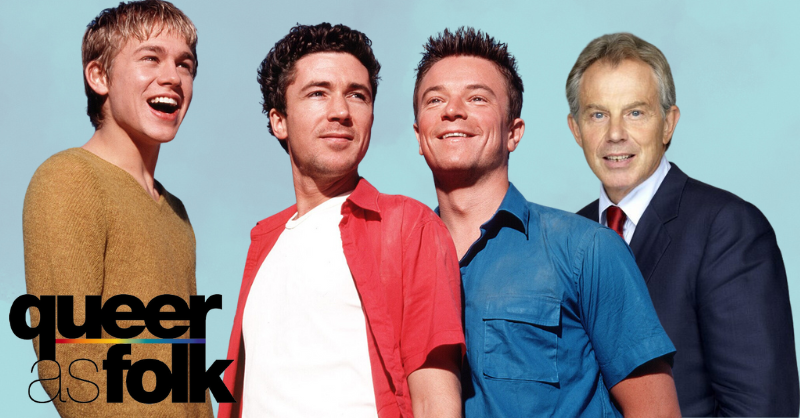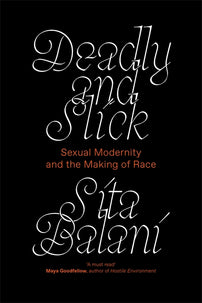Queer as Folk, The New Labour project, and Sexual Modernity
Queer As Folk functions as a prescient parable for New Labour’s political philosophy.

Queer as Folk aired in the UK on Channel 4 in February 1999. Written by Russell T. Davies, it was hailed by The Guardian as the ‘first gay drama on British TV’. The eight-episode series unfolded with a relentless comic energy. Revolving around Manchester’s gay village, Queer as Folk follows the lives of three men – Stuart, Vince, and Nathan – as they navigate sex, work, family, love, and friendship.
Rather than being an incidental backdrop, a vibrant, confident, commercial gay culture is at the heart of the programme. The characters who inhabit this culture function as archetypes: Stuart is the playboy – rich, handsome, arrogant; Vince, a Dr Who obsessive who works as a manager in a supermarket, is his long-suffering sidekick, admirer, and best friend; Nathan is a Stuart-in-the-making, a cocksure teenager quickly learning that being young and handsome is real currency on ‘the scene’.
A supporting character, Lance, is a straight African man (his country of origin is not specified), who is marrying Romey, a lesbian, to obtain a visa. Stuart tries to stop the marriage because he feels it will endanger his paternity rights, as he is the father of Romey’s baby. At the end of the first series, Lance is arrested and threatened with deportation after Nathan reports him to the Home Office in an attempt to win Stuart’s affections. When confronted by the police, Lance lashes out, punching two officers in the face. The show’s most likeable character, Hazel, Vince’s mother, comments to Romey, ‘do you want a man like that living with your kid?’, thus cementing Lance’s inferior position in the programme’s moral economy.
This watershed programme in British television functions as a prescient parable for New Labour’s political philosophy. Led by Tony Blair, New Labour sought to make a ‘historic break’ with the political orientation of the traditionally left-wing party in favour of what Seumas Milne described as ‘an unconditional embrace of the new rules of the globalised economic game’. Queer As Folk aired less than two years into Blair’s government and shared something of the energy of New Labour.
Though New Labour had many critics, accounts of the period almost universally refer to a sense of optimism in 1997, with the entropy and scandal of John Major’s government giving way to a project organised around being ‘modern’ and ‘progressive’. Though this upbeat rhetoric came with Labour implementing highly reactionary policies, in 1997, the end of a long period of Tory rule brought some hope that Britain could shake off its atmosphere of terminal decline.
With its relentless, driving, extra-diegetic theme music, fast-paced editing, and focus on individual potential (whether sexual, social, or economic), Queer as Folk captured the ‘structure of feeling’ of the late 1990s. The gay lifeworld depicted in the programme is not the left-wing, militant political culture of Lesbians and Gays Support the Miners or ACT UP – indeed, the show was criticised for largely ignoring the AIDS epidemic – but a culture organised around commercial bars and clubs.
While homophobia persists in the show, it is framed as prejudice to which individuals respond. In Queer as Folk, they do so through outlandish and highly entertaining acts of revenge. For example, when a car salesman tries to steer Stuart in the direction of buying a more ‘masculine’ car (suggesting the sport is for gay men who are ‘cutting edge with money to burn’ but who shouldn’t be taken too seriously), Stuart drives a Jeep through the glass showroom window. Individual acts of resistance – ideally performed with style – are viewed as the only viable way to respond to stigma.
Lance’s presence on the programme coincided with the figure of the ‘bogus asylum seeker’ gaining wide purchase as a distinctly New Labourite scapegoat. In the late 1990s and early 2000s, Britain’s moral panic about migration was channelled into this folk devil, inherited from the last days of Major’s rule but used to far greater effect by Blair. Headlines denouncing people seeking asylum as fakes, criminals, rapists, or murderers, offered a powerful story of a national polity under siege, while the moral panic surrounding benefit fraud suggested a dangerous enemy within.
Under New Labour’s governance, ‘the Muslim terrorist’, the ‘bogus asylum seeker’ and the ‘benefits scrounger’ were placed in stark contrast with the increasingly acceptable figure of the white gay man. The latter was viewed as the apex of sexual modernity: socially mobile, with a disposable income and concern for appearances deemed highly compatible with New Labour’s ideology of individualism and self-sufficiency. New Labour saw homophobia as an outdated stigma that prevented gays from realising their potential as full economic actors and citizens of the nation. As such, New Labour introduced legislation designed to counter this residual stigma and incentivise organising one’s intimate connections into the respectable couple form. As Natalie Edwards explains, ‘Their integration into the national community, in short, is worth more to the government, and to the British economy, than their exclusion’.
While the gay characters in Queer as Folk cannot be reduced to this rather flat view of gay potential, they are nonetheless shown to be flexible, economic agents whose identities are significantly undergirded by consumer goods, especially cars and mobile phones. ‘The Lesbians’, as they are referred to in the show, however, are another matter. Romey’s ‘sham’ marriage to Lance appears to be motivated by solidarity and is swiftly punished in the show’s moral economy. This portrayal of ‘The Lesbians’ as having a dangerous set of political attachments echoes the Thatcherite moral panic about the infiltration of lesbians into local government as the harbingers of the so-called ‘Loony Left’.
Queer as Folk encapsulates the contradictory pulls of the New Labour project and hints at the racial regime produced and maintained by its Janus-faced political project. In the programme, gay men are presented as the ideal subjects of the market – as adaptable, modern individuals. For these ideal individuals to flourish, however, others must be managed, punished, or excluded. Lance needs to be banished from the moral universe for Stuart, Nathan, and Vince’s world to be maintained. Lance’s punishment – orchestrated by Stuart, Nathan, and Romey’s jealous girlfriend but enacted by the police and border agents – places the state on the side not only of the gay community but also of the self-interested individual, unmoved by the possibility of solidarity or even a more liberal, altruistic charity.
A similar fortification of the individual as the basic unit of organisation was crucial to New Labour’s use of racial governance. Muslims, for example, were viewed as perversely clannish and therefore susceptible to violence and disorder, while Hindus and Sikhs were placed closer to their white counterparts in their capacity to fulfil the promise of sexual modernity. Like gay men, they were seen as ripe for assimilation into modern sexual norms.
— An edited excerpt from Deadly and Slick: Sexual Modernity and the Making of Race by Sita Balani
